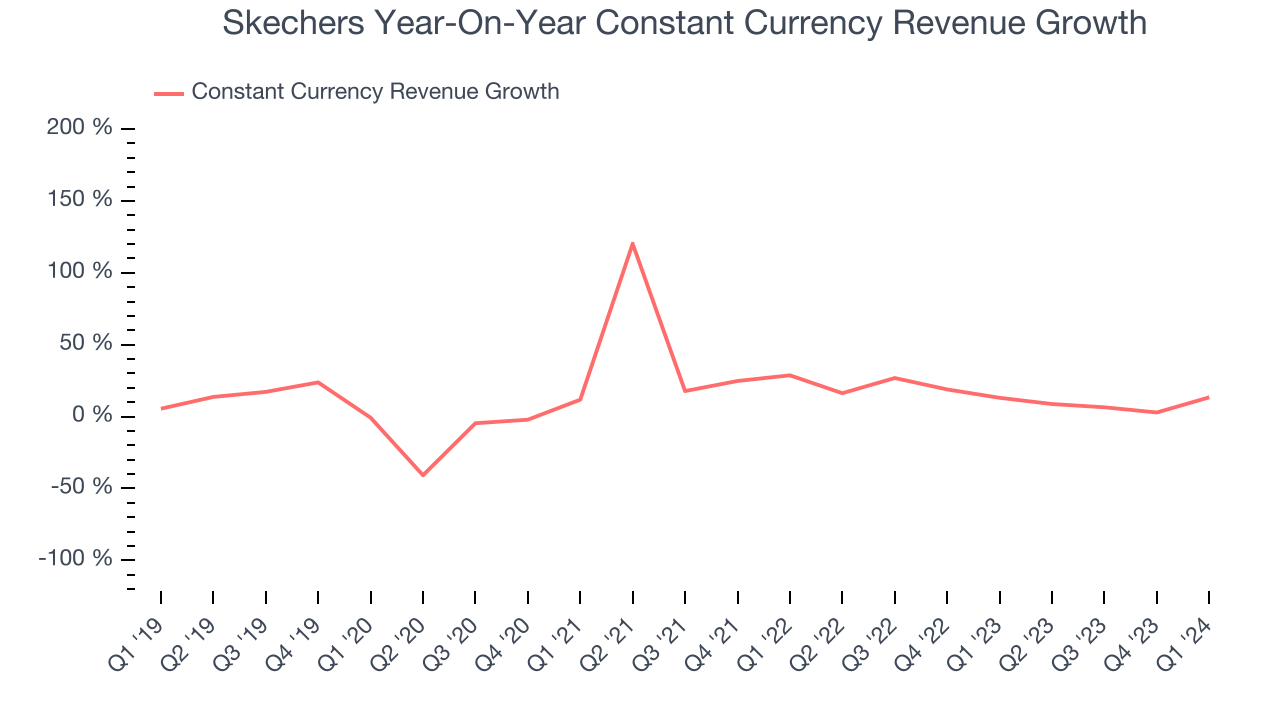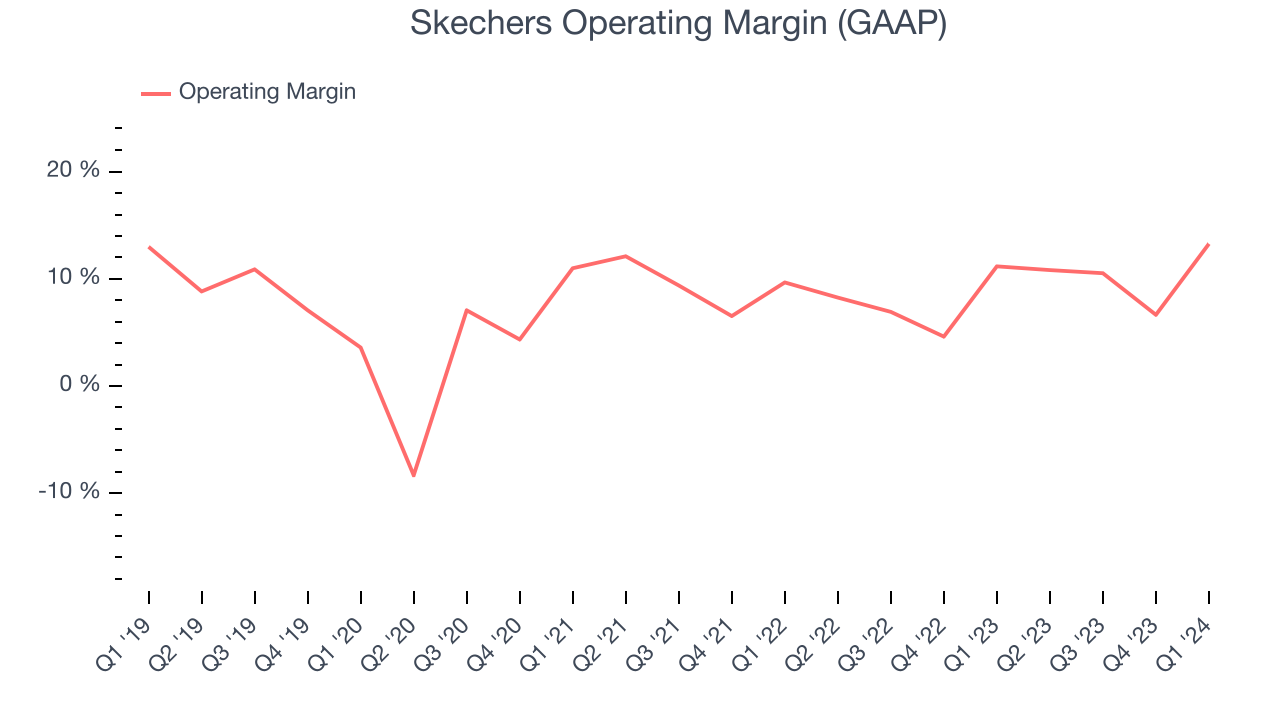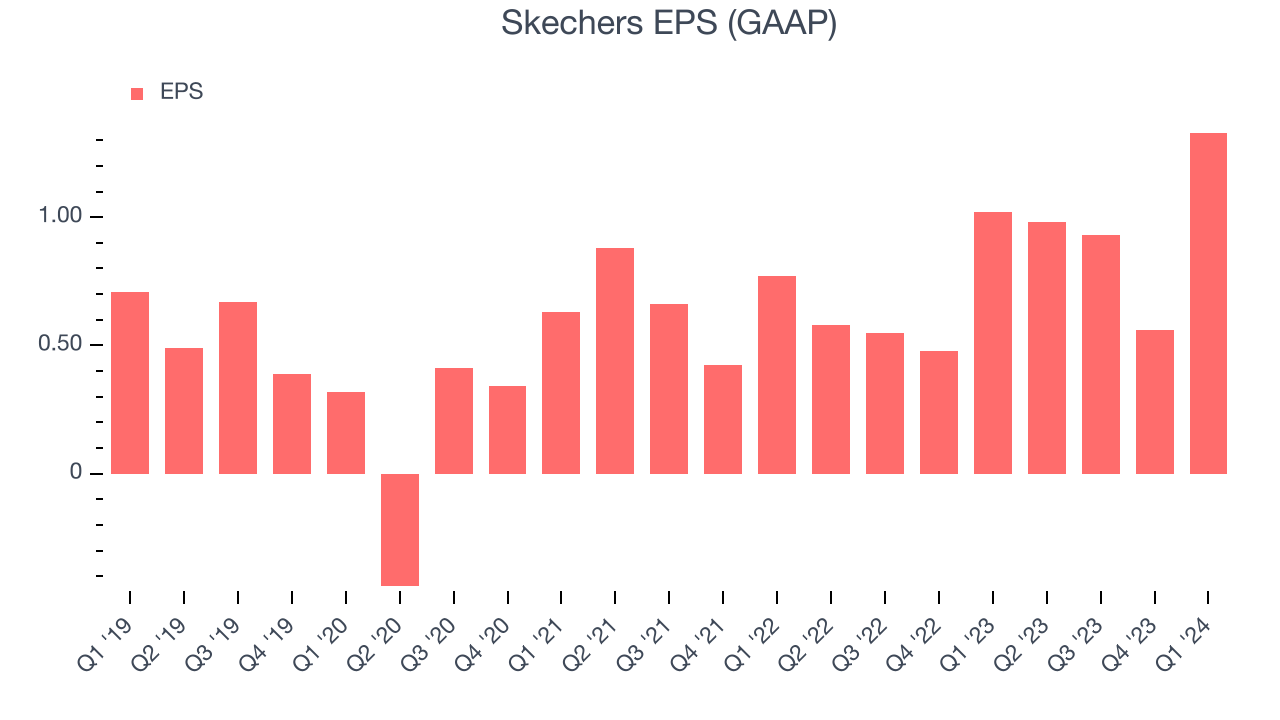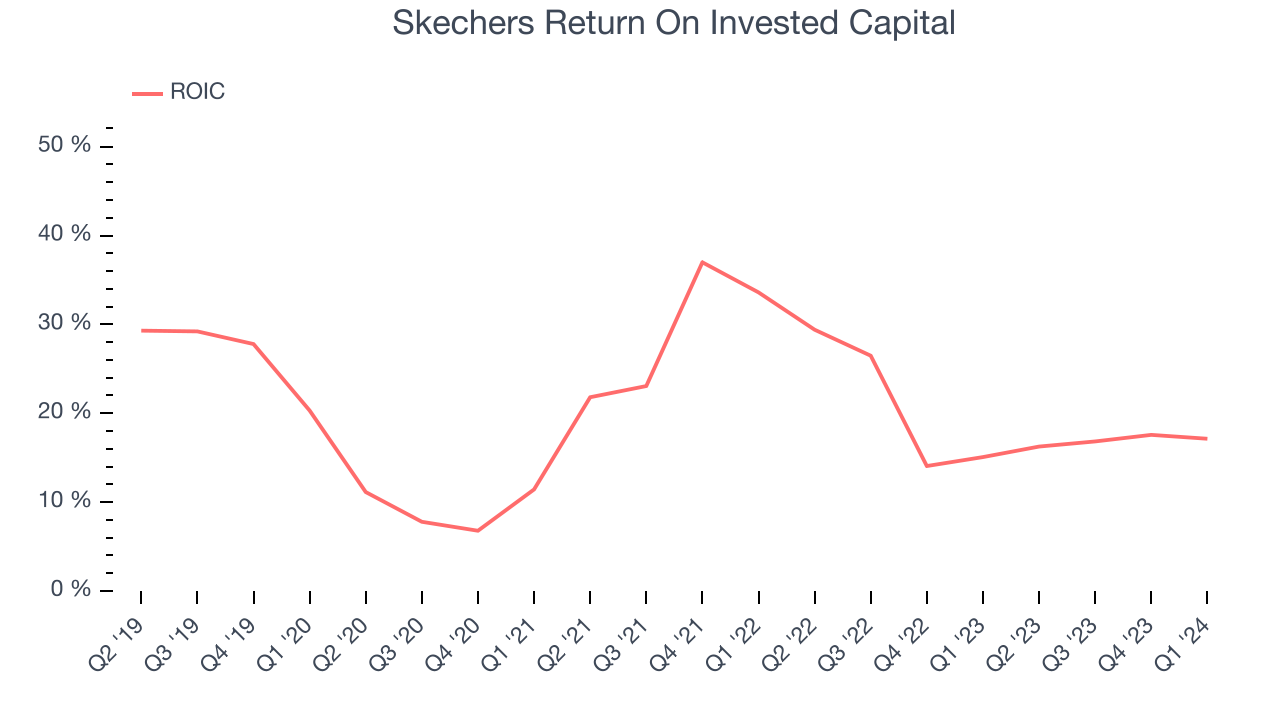Footwear company Skechers (NYSE:SKX) reported Q1 CY2024 results exceeding Wall Street analysts' expectations, with revenue up 12.5% year on year to $2.25 billion. The company expects next quarter's revenue to be around $2.2 billion, in line with analysts' estimates. It made a GAAP profit of $1.33 per share, improving from its profit of $1.02 per share in the same quarter last year.
Skechers (SKX) Q1 CY2024 Highlights:
- Revenue: $2.25 billion vs analyst estimates of $2.2 billion (2.3% beat)
- EPS: $1.33 vs analyst estimates of $1.10 (20.6% beat)
- Revenue and EPS Guidance for full year 2024 both raised, both above Consensus expectations
- Gross Margin (GAAP): 52.5%, up from 48.9% in the same quarter last year
- Store Locations: 5,203 at quarter end, increasing by 654 over the last 12 months
- Market Capitalization: $9.24 billion
Synonymous with "dad shoe", Skechers (NYSE:SKX) is a footwear company renowned for its comfortable, stylish, and affordable shoes for all ages.
Initially starting as a utility boot and skate shoe company, Skechers has diversified its product line to include a wide array of footwear styles for men, women, and children, along with a growing range of apparel and accessories.
Skechers rose in the footwear market with their focus on style, comfort, and affordable pricing. The brand is known for its memory foam sneakers, performance shoes, casual slip-ons, and stylish sandals. Each product line caters to different lifestyles and age groups, targeting a broad consumer base.
The company has invested significantly in developing comfortable and functional shoes, incorporating technologies such as memory foam insoles and lightweight, shock-absorbing midsoles. This focus on comfort has set Skechers apart in the lifestyle and athletic footwear segments.
To build its brand, Skechers employs a multi-faceted marketing approach, utilizing celebrity endorsements, television, and digital advertising, along with high-profile sports sponsorships. This has not only enhanced its visibility but also positioned Skechers as a trendy and relatable brand across various demographics.
Footwear
Before the advent of the internet, styles changed, but consumers mainly bought shoes by visiting local brick-and-mortar shoe, department, and specialty stores. Today, not only do styles change more frequently as fads travel through social media and the internet but consumers are also shifting the way they buy their goods, favoring omnichannel and e-commerce experiences. Some footwear companies have made concerted efforts to adapt while those who are slower to move may fall behind.
Skechers' primary competitors include Nike (NYSE:NKE), Adidas (ETR:ADS), Under Armour (NYSE:UAA), Puma (ETR:PUM), and private company New Balance.Sales Growth
Examining a company's long-term performance can provide clues about its business quality. Any business can put up a good quarter or two, but the best consistently grow over the long haul. Skechers's annualized revenue growth rate of 12.1% over the last five years was mediocre for a consumer discretionary business.

Within consumer discretionary, product cycles are short and revenue can be hit-driven due to rapidly changing trends. That's why we also follow short-term performance. Skechers's recent history shows the business has slowed as its annualized revenue growth of 11% over the last two years is below its five-year trend. Skechers also reports sales performance excluding currency movements, which are outside the company’s control and not indicative of demand. Over the last two years, its constant currency sales averaged 13.3% year-on-year growth. Because this number is higher than its revenue growth during the same period, we can see that foreign exchange rates have been a headwind for Skechers.

This quarter, Skechers reported robust year-on-year revenue growth of 12.5%, and its $2.25 billion of revenue exceeded Wall Street's estimates by 2.3%. The company is guiding for revenue to rise 9.3% year on year to $2.2 billion next quarter, improving from the 7.7% year-on-year increase it recorded in the same quarter last year. Looking ahead, Wall Street expects sales to grow 9.4% over the next 12 months, a deceleration from this quarter.
Operating Margin
Operating margin is a key measure of profitability. Think of it as net income–the bottom line–excluding the impact of taxes and interest on debt, which are less connected to business fundamentals.
Skechers was profitable over the last two years but held back by its large expense base. It's demonstrated mediocre profitability for a consumer discretionary business, producing an average operating margin of 9.2%.
This quarter, Skechers generated an operating profit margin of 13.3%, up 2.1 percentage points year on year.
Over the next 12 months, Wall Street expects Skechers to maintain its LTM operating margin of 10.4%.EPS
Analyzing long-term revenue trends tells us about a company's historical growth, but the long-term change in its earnings per share (EPS) points to the profitability and efficiency of that growth–for example, a company could inflate its sales through excessive spending on advertising and promotions. 
Over the last five years, Skechers's EPS grew 101%, translating into a solid 15% compounded annual growth rate.
In Q1, Skechers reported EPS at $1.33, up from $1.02 in the same quarter last year. This print beat analysts' estimates by 20.6%. Over the next 12 months, Wall Street expects Skechers to grow its earnings. Analysts are projecting its LTM EPS of $3.80 to climb by 8.3% to $4.12.
Return on Invested Capital (ROIC)
EPS and free cash flow tell us whether a company was profitable while growing revenue. But was it capital-efficient? A company’s ROIC explains this by showing how much operating profit a company makes compared to how much money the business raised (debt and equity).
Although Skechers hasn't been the highest-quality company lately, it historically did a solid job investing in profitable business initiatives. Its five-year average return on invested capital was 19.5%, higher than most consumer discretionary companies.

The trend in its ROIC, however, is often what surprises the market and drives the stock price. Uneventfully, Skechers's ROIC has stayed the same over the last few years. This is fine because its returns are solid, but if the company wants to become an investable business, it will need to increase its ROIC even more.
Key Takeaways from Skechers's Q1 Results
This was one of those rare 'beat and raise' quarters you love to see. We were impressed by how significantly Skechers blew past analysts' constant currency revenue expectations this quarter. We were also excited its operating margin outperformed Wall Street's estimates. Looking forward to the full year, the company raised its revenue and EPS guidance for 2024 and both are comfortably ahead of analysts' expectations. Overall, this quarter's results seemed fairly positive and shareholders should feel optimistic. The stock is up 7.4% after reporting and currently trades at $63.15 per share.
Is Now The Time?
Skechers may have had a favorable quarter, but investors should also consider its valuation and business qualities when assessing the investment opportunity.
We cheer for all companies serving consumers, but in the case of Skechers, we'll be cheering from the sidelines. Its revenue growth has been a little slower over the last five years. And while its solid ROIC suggests it has grown profitably in the past, the downside is its low free cash flow margins give it little breathing room. On top of that, its constant currency sales performance has been disappointing.
Skechers's price-to-earnings ratio based on the next 12 months is 14.3x. While there are some things to like about Skechers and its valuation is reasonable, we think there are better opportunities elsewhere in the market right now.
Wall Street analysts covering the company had a one-year price target of $69.92 per share right before these results (compared to the current share price of $63.15).
To get the best start with StockStory, check out our most recent stock picks, and then sign up for our earnings alerts by adding companies to your watchlist here. We typically have the quarterly earnings results analyzed within seconds of the data being released, and especially for companies reporting pre-market, this often gives investors the chance to react to the results before the market has fully absorbed the information.
